 Edit article
Edit articleSeries
What Is the Biblical Flying Serpent?

Sheet gold collar depicting the winged serpent goddess Wadjet found in King Tutankhamun’s tomb New Kingdom 18th Dynasty Egypt 1332-1323 BCE. This reproduction was photographed at The Discovery of King Tut” exhibition. Credit: Mary Harrsch – Flickr
Burning Serpents in the Wilderness
In Numbers 21, the Israelites begin to grumble about the lack of normal food and water in the wilderness as they walk the long way around Edom. YHWH’s response is characteristically harsh:
במדבר כא:ו וַיְשַׁלַּח יְ-הוָה בָּעָם אֵת הַנְּחָשִׁים הַשְּׂרָפִים וַיְנַשְּׁכוּ אֶת הָעָם וַיָּמָת עַם רָב מִיִּשְׂרָאֵל.
Num 21:6 YHWH sent saraph serpents against the people. They bit the people and many of the Israelites died.
The people then turn to Moses to intercede with YHWH, which he does:
במדבר כא:ז וַיָּבֹא הָעָם אֶל מֹשֶׁה וַיֹּאמְרוּ חָטָאנוּ כִּי דִבַּרְנוּ בַי-הוָה וָבָךְ הִתְפַּלֵּל אֶל יְ-הוָה וְיָסֵר מֵעָלֵינוּ אֶת הַנָּחָשׁ וַיִּתְפַּלֵּל מֹשֶׁה בְּעַד הָעָם.
Num 21:7 The people came to Moses and said, “We sinned by speaking against YHWH and against you. Intercede with YHWH to take away the serpents from us!” And Moses interceded for the people.
In response, YHWH offers a magical way to survive the snake bite:
במדבר כא:ח וַיֹּאמֶר יְ-הוָה אֶל מֹשֶׁה עֲשֵׂה לְךָ שָׂרָף וְשִׂים אֹתוֹ עַל נֵס וְהָיָה כָּל הַנָּשׁוּךְ וְרָאָה אֹתוֹ וָחָי. כא:ט וַיַּעַשׂ מֹשֶׁה נְחַשׁ נְחֹשֶׁת וַיְשִׂמֵהוּ עַל הַנֵּס וְהָיָה אִם נָשַׁךְ הַנָּחָשׁ אֶת אִישׁ וְהִבִּיט אֶל נְחַשׁ הַנְּחֹשֶׁת וָחָי.
Num 21:8 Then YHWH said to Moses, “Make a saraph figure and mount it on a standard. And if anyone who is bitten looks at it, he shall recover.” 21:9 Moses made a copper serpent and mounted it on a standard; and when anyone was bitten by a serpent, he would look at the copper serpent and recover.
The story uses two terms to refer to these creatures: נָּחָשׁ (naḥash) and שָׂרָף (saraph).
- The initial attack against the Israelites is by creatures described as נְחָשִׁים שְׂרָפִים neḥashim seraphim; v. 6).
- The Israelites ask Moses to pray on their behalf to turn away הַנָּחָשׁ hanaḥas; v. 7).[1]
- YHWH then instructs Moses to make a שָׂרָף saraph; v. 8).
- Moses makes a נְחַשׁ נְחֹשֶׁת (neḥash neḥoshet; a copper snake,[2] ostensibly of the same type as those that bit the Israelites) so that anyone bitten by the נָּחָשׁ naḥash) can look at נְחַשׁ הַנְּחֹשֶׁת and live (vv. 9-10).
The word נָּחָשׁ (pl. נְחָשִׁים) is the generic Hebrew term for snake or serpent The term שָׂרָף (pl. שְׂרָפִים) is less clear. It comes from a root that means “to burn.” Sometimes, the term is used adjectivally to modify snakes, as in the phrase נְחָשִׁים שְׂרָפִים (v. 6), which means “flaming serpents” or “burning serpents,” perhaps describing the bite or sting of the creature. At other times it is used as a standalone term, שָׂרָף, a substantive adjective meaning “the flaming one” or “the burning one.”
Does the term indicate a property of a snake, perhaps a venomous snake, or a particular breed of snake?
Three Further Biblical References to Saraph Serpents
Three other biblical references to seraphim shed light on the nature of this creature: [4]
1. Deut 8:15 A Wilderness Filled with Saraph Serpents and Scorpions
Deuteronomy 8:15 has Moses warning the Israelites not to take for granted all of the benefits bestowed upon them by YHWH, including YHWH’s protection during the dangerous wilderness crossing:
דברים ח:טו הַמּוֹלִיכְךָ בַּמִּדְבָּר הַגָּדֹל וְהַנּוֹרָא נָחָשׁ שָׂרָף וְעַקְרָב וְצִמָּאוֹן אֲשֶׁר אֵין-מָיִם
Deut. 8:15 who led you through the great and terrible wilderness with serpents, saraphim,[5] and scorpions,[6] a parched land with no water in it.
This passage is resonant with the passage in Numbers; it too mentions these creatures in connection with the dangers faced by the Israelites in the wilderness. The mention of scorpions suggests that we are dealing with biting or stinging venomous creatures found in the dry, parched desert. An inscription of the Assyrian king Esarhaddon (681-669 B.C.E.) recounting a military campaign in Arabia offers a similar description of the Arabian peninsula as “a waterless region… a place of serpents and scorpions.”[7]
2. Isa 14:29 – Cursing Philistia with a Flying Saraph
In an oracle directed against the Philistines, Isaiah 14:29 uses both naḥash and saraph as poetic parallels:
ישעיהו יד:כט אַל-תִּשְׂמְחִי פְלֶשֶׁת כֻּלֵּךְ,
כִּי נִשְׁבַּר שֵׁבֶט מַכֵּךְ:
כִּי-מִשֹּׁרֶשׁ נָחָשׁ יֵצֵא צֶפַע,
וּפִרְיוֹ שָׂרָף מְעוֹפֵף.
Isaiah 14:29 Rejoice not, all Philistia,
Because the staff of him that beat you is broken.
From the stock of a snake there sprouts an asp,
And its fruit will be a flying saraph.
This passage, dated to the end of the reign of Ahaz and the beginning of the reign of Hezekiah (Isa 14:28), places it in a politically fraught period. As king, Ahaz acquiesced to Assyrian domination, but upon his ascension to the throne in 715 B.C.E., his son Hezekiah changed allegiance to Egypt and led a rebellion against the Assyrian king. The Philistines, too, fought Assyrian domination during this period.[8]
It is commonly assumed that Isaiah is warning the Philistines of an Assyrian advance, in effect, addressing the Philistines in absentia that the Assyrians are flying serpents poised to attack. J.J.M. Roberts, however, understands this passage as a response to the Philistines’ desire to have the Kingdom of Judah join their anti-Assyrian coalition. Isaiah warns the Philistines, in absentia, that although Hezekiah will indeed join the rebellion, he also has designs on Philistine territory. Indeed, 2 Kings 18:8 informs us that Hezekiah does eventually wage war against the Philistines. If this is the case, then Hezekiah is the aggressive and dangerous “flying serpent.”
3. Isa 30:6 – The Negev Filled with Lions, Adders, and Flying Saraph
Isaiah 30:6 rebukes those who rely on Egypt for protection:
ישעיהו ל:ו מַשָּׂא בַּהֲמוֹת נֶגֶב: בְּאֶרֶץ צָרָה וְצוּקָה לָבִיא וָלַיִשׁ מֵהֶם אֶפְעֶה וְשָׂרָף מְעוֹפֵף
Isaiah 30:6 A prophecy concerning the animals of the Negev: Through a land of hardship and distress, of lion and lioness, of adder and flying saraph.
Here the flying saraph is parallel to the אֶפְעֶה (epha; “adder”). The parallel is similar in the above passage, in which it is parallel to the צֶפַע (tzepha; “asp”).[9] Both of these are venomous snakes. The eminent Israeli archeologist Yohanan Aharoni (1919-1976) states,
In the Bible only poisonous snakes are mentioned, and all their names have an ‘f’ as an imitation of their blowing and puffing: ‘tzefa’, ‘tzif’oni’, ‘ef’eh’, ‘sh’fifon’, ‘fethen’.[10]
The description of flying serpents in the desert is not unique to the 8th century prophet, Isaiah. An account of the campaign against Egypt conducted by the 7th century B.C.E. Assyrian king, Esarhaddon, mentions “snakes with deadly breath and yellow flying serpents.”[11] Likewise, the Greek historian Herodotus, writing in the 5th century B.C.E., writes of flying serpents that inhabited the Arabian desert and apparently frequently attacked Egypt.[12]
The Saraph, the Cobra, and the Uraeus
The saraph should be understood as a type of venomous desert snake that some texts describe as flying, but can we narrow it down further?
The Hebrew name for this (flying) venomous serpent of the desert is saraph, i.e., “the burning one.” In Egypt, the cobra was often referred to as “the flaming one,”[13] an image of which, called a uraeus, was worn by the Pharaoh. Thus, saraph may be the Hebrew term for cobra.
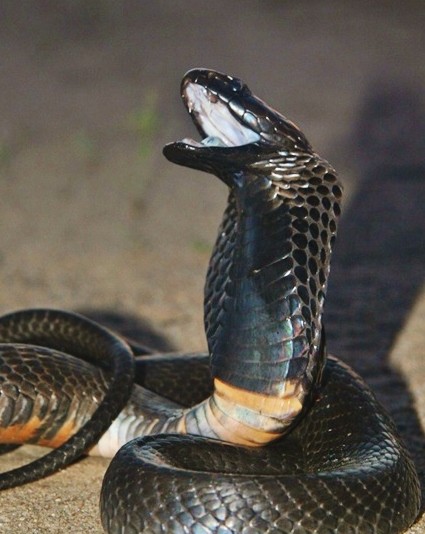
Black Necked Spitting Cobra (Naja nigricollis)
Othmar Keel and Karl Uehlinger identify the uraeus cobra as “the black-necked cobra (Naja nigricollis), which applies its poison both by biting and spitting.”[14] These cobras do not fly, but swing through trees and attack from the air. Such an attack could easily be imagined or depicted as flying.[15] Moreover, these snakes are often yellowish-copper in color, which would fit with the image of a copper serpent depicted in Numbers 21.
Nevertheless, it is problematic to identify the flying serpents of the desert in Isaiah, Esarhaddon, and Herodotus with this species. Naja nigricollis is primarily a sub-Saharan species; they would not be in Egypt, let alone in the Sinai or Arabian peninsulas. Furthermore, they only “fly” when living in trees and attacking from above, but the desert does not have trees.
Reimagining Local Cobras
Saraph is likely not a specific species, but refers to cobras in general. By definition, no species of desert cobra “flies,” since “flying” requires trees, but it is possible that legend overlaid the local desert cobras with the imperfectly understood characteristics of flying cobras, based on a vague knowledge these authors had of “flying” cobras in distant lands.[16]
A number of cobra (or cobra-like) species of venomous snake inhabit Egypt and the Levant:
- The Egyptian cobra (Naja haje) is a very large species that transmits its deadly venom by biting (not spitting) and is found in many colors, including reddish-copper. It is not a desert snake, however.
- The Arabian cobra (Naja arabica) inhabits the Arabian Peninsula, among other places, and is closely related to the Egyptian cobra.
- The desert black snake (Walterinnesia aegyptia), popularly known as the Sinai Desert cobra or the black desert cobra, is a venomous serpent inhabiting the Sinai desert. It is not an actual cobra, but looks very much like one.
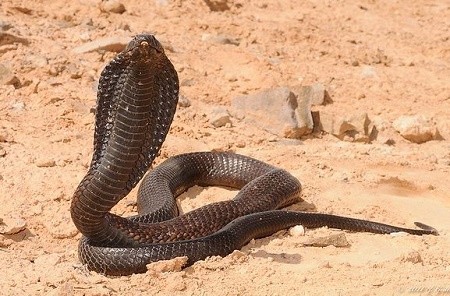 |
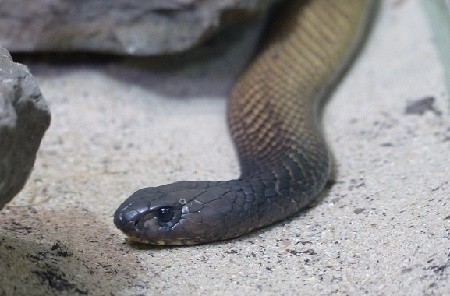 |
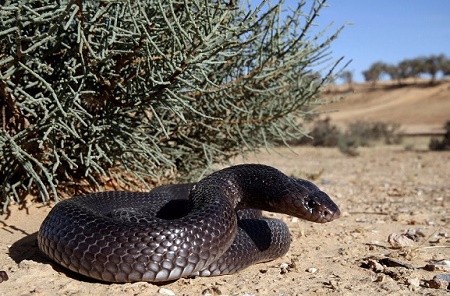 |
| Egyptian cobra (Naja haje). Credit: J. Gállego-Flickr | Arabian cobra (Naja arabica) Credit: Christoph Lorse-Flickr | desert black snake (Walterinnesia aegyptia) Credit: Cowyeow-Flickr |
The above is a possible explanation for the origin of the flying desert cobra legend, but Egyptian iconography presents us with another, perhaps more plausible one.
Flying Serpents and the Winged Uraeus
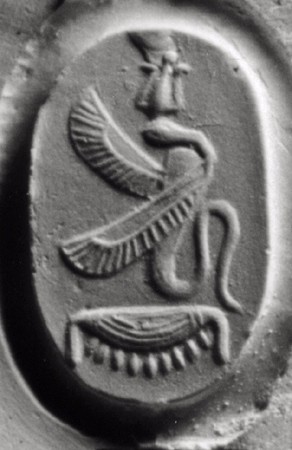
As noted above, the pharaoh’s uraeus was a cobra, which we have identified as the saraph. This same uraeus was often depicted in Egyptian iconography as a (two- or four-)winged serpent called the winged uraeus, whose wings symbolize protection. This was a popular iconographic motif throughout not only Egypt, but also Syria/Palestine going back to the Late Bronze Age. This same Egyptian winged-uraeus image became popular in late 8th century Judah during the reign of King Hezekiah and appears on numerous seals during this period.[17]
It seems quite possible that travelers familiar both with the Egyptian imagery of flying serpents and knowledge that the desert is filled with venomous snakes, imagined flying serpents in the desert. As Othmar Keel points out, humans encounter the desert with something of an air of mystery, a place filled with all kinds of danger, exemplified by exotic and mysterious flora and fauna.[18]
Postscript: Danger and Healing
The various depictions of the dangers of the desert found in Deuteronomy, Isaiah, Esarhaddon, and Herodotus, all convey the dread that travelers felt about encountering these darting, “burning,” venomous cobras while travelling in the desert regions of Egypt, the Sinai, or Arabia. In the form of a uraeus, the cobra was chosen to be the patron of the Pharaoh, communicating both his dangerous power as well as the idea that he was under the protection of the cobra goddess, Wadjet.[19]
In the story in Numbers, the saraph has a similar dual function. The serpents themselves effect God’s wrath by biting and poisoning the Israelites. At the same time, the image of the copper serpent conveys God’s healing power. Thus, in Egyptian iconography as well as in the biblical account in Numbers, the cobra is both a giver and protector of life—an image of healing, but also a dangerous and destructive creature.
TheTorah.com is a 501(c)(3) nonprofit organization.
We rely on the support of readers like you. Please support us.
Published
January 1, 2015
|
Last Updated
January 3, 2026
Previous in the Series
Next in the Series
Before you continue...
Thank you to all our readers who offered their year-end support.
Please help TheTorah.com get off to a strong start in 2025.
Footnotes

Dr. Richard Lederman taught courses in Bible, Religion, and Comparative Mythology at Georgetown University, Montgomery College, and Gratz College. He holds a Ph.D. in Ancient Near Eastern Languages and Literature from Dropsie College. Before returning to academia, Lederman worked as a Jewish communal professional. He blogs at thereligioushumanist.com and spiritunboundsandr.blogspot.com.
Essays on Related Topics:









